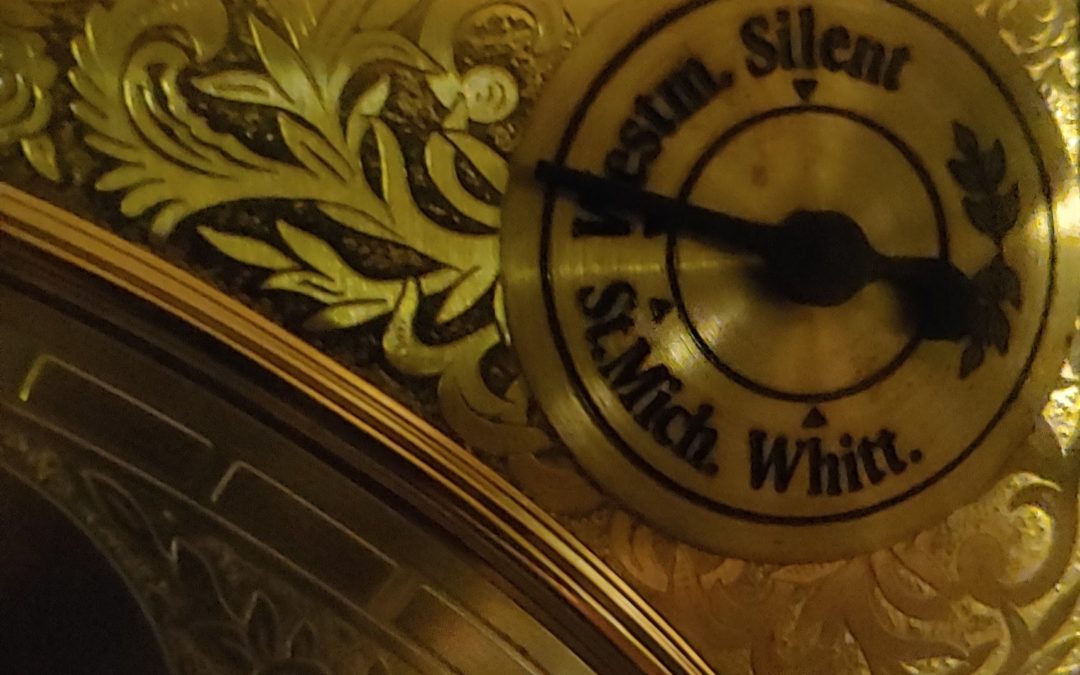A dear family friend, the “elder stateman” in our church, recently passed on to us the treasure of an heirloom grandfather clock. Made by the people of Howard Miller, who have honed their craft since 1926, it is a work of art. And it has literally changed life here, becoming like a heart at the central-most place of our modest Homestead – reconnecting us with Time in a way that has surprised us, and making us more intentional about giving thanks…for Time.
We hired a local clockmaker (92 years of age) who sent his clockmaker son to disassemble the clock. We transported it here, where the clockmaker son met us to re-assemble it. As I watched him do his work, and the weights were raised and the pendulum bob started to move, I felt like I had stepped into Hans Zimmer’s Tick-Tock track from the movie Interstellar.
The clockmaker introduced us, formally, to the clock: he explained the history, workings and preferences of all seven glorious feet of it. The inner workings are a model of German precision: Howard Miller Clock Company owns the Kieninger Company of Germany, which makes many of the mechanical movements in Howard Miller clocks.
He told us that in our day, with watches and mobile phones, it’s easy to forget that people once told time by the chimes of the bells – sometimes in their homes, sometimes from the belfries (mostly churches) nearest them.
People kept time by ear.
Though we’ll use the St. Michael Chimes at the Homestead on holidays, our daily cadence has become the Westminster Chimes, which is also called the Cambridge Quarters because it first played at St. Mary’s Church in Cambridge. Tradition and history holds that it is set to Handel’s classic piece, My Redeemer Liveth.
The Westminster Chimes has been and remains the most common chime for striking clocks the world over, from Hong Kong to Delhi, from Budapest to Amsterdam; from Boston (where it first sounded in America at Trinity Church) to the Peace Tower in Ottawa. In Indonesia, the chimes are played at train stations as a sign of train departures and arrivals. At New York’s Yankee Stadium, the chimes are played when the Yankees score a run.
But no place is more synonymous with the Westminster Chimes than London’s Big Ben clock tower at the northern end of the Houses of Parliament. The prayer inscribed on a plaque in its clock room reads:
All through this hour
Lord be my guide
That by Thy power
No foot shall slide.
The dance from the Whence to Whither, through the Living Present, connects and reconnects us with Time. We can use it, redeem it, waste it – or worse. On the whole, we make time (and spend money) on what we feel is important in our lives. Sometimes in the blur of life we don’t think much of it. Though in the end, Time has a way of showing us what really matters.
All this to say that, for us, the new presence of the ticking of the clock and the striking of the quarter-hours has reminded us of the importance of connecting to Time. “So teach us,” as the Psalmist says to the Lord (Psalm 90:12), “to number our days that we may get a heart of wisdom.”
Being conscious of Time can enrich our days. We’re learning a little better I think how to be grateful for the Past, Present and Future tense; how to be grateful for the days we’re given without a spirit of entitlement to more days than our Maker allots to us; how to be grateful for the ways Time sets us against specific goals with accountability.
We’re learning to be more grateful even for the hope we have for liberation from Time.
May Time accompany you well, and help fill you and yours with gratefulness for each day.
P.S. You can listen to the Westminster Chimes below.
Make sharing easy!


Well said brother. How very important it is for us to number our days to get a heart of wisdom. Happy Thanksgiving.
Reminds me of being at my grandmother’s house and spending time with my fav Aunt. Fond memories. Thanks.
This piece was very timely for me, as I aspire to steward the time God has given me.